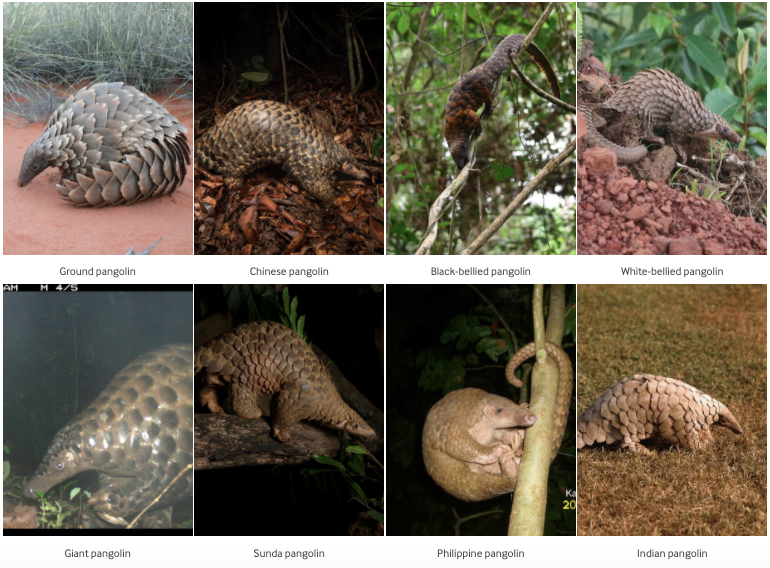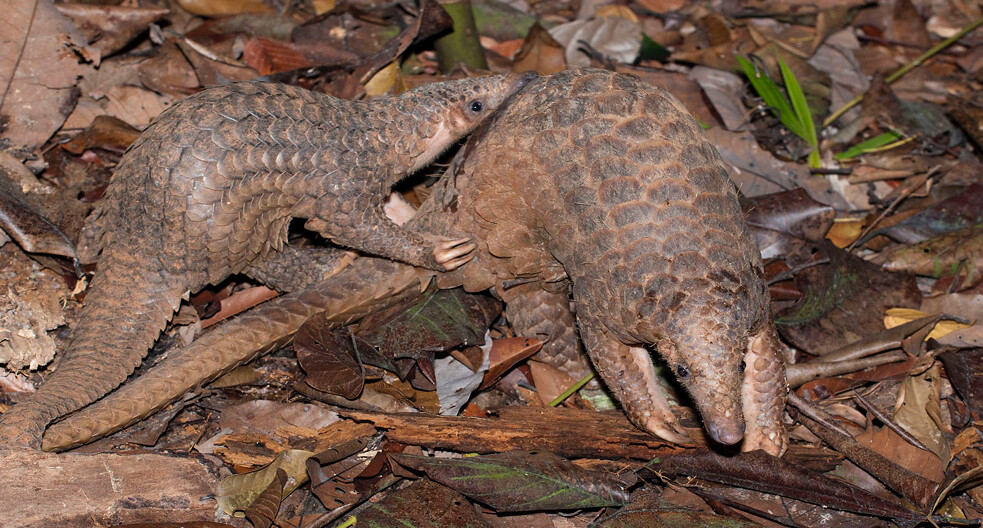
What's In This Article
What Is A Pangolin?
Although many people see them as reptiles. Pangolins are actually mammals. They are in fact unique as the only mammals currently found covered wholly in tough overlapping scales. Using these scale to protect against predators in the wild. When under threat Pangolins curl into a tight ball-like shape and when called for will use their scaled tails to defend themselves.
There are eight species of pangolins. With those in Asia listed by the IUCN as critically endangered and with those in Africa listed as vulnerable. Currently, all species face declining population rates.
African Pangolins:
- Ground pangolin (Smutsia temminckii) – Vulnerable
- White-bellied pangolin (Phataginus tricuspis) – Vulnerable
- Giant pangolin (Smutsia gigantea) – Vulnerable
- Black-bellied pangolin (Phataginus tetradactyla) – Vulnerable
Asian Pangolins:
- Chinese pangolin (Manis pentadactyla) – Critically Endangered
- Sunda pangolin (Manis javanica) – Critically Endangered
- Indian pangolin (Manis crassicaudata) – Endangered
- Palawan pangolin (Manis culionensis) – Endangered

Pangolin – The Most Trafficked Mammal In The World?
Pangolins are one of the most trafficked mammals in Asia and, increasingly, Africa. They are in high demand due to countries such as China and Vietnam. Where Pangolin meat is considered a delicacy. Alongside Pangolin scales for use in folk remedies and traditional medicine. During the years of 2011 and 2013 reviewing reported seizures. An estimated 115,000 to 230,000 Pangolins had been killed. A figure which represents only those caught. With experts beelining in fact this represents only as much as 10% of the total Pangolin illegal wildlife trade volume.
Their value in traditional Chinese medicine comes from the concept they could help with ailments ranging from lactation difficulties to arthritis. However, Pangolin scales are made of keratin, the same material that makes up hair, fingernails, and horn. They are often found or discovered in stores dried and ground up into a powder.

Why Has Nothing Been Done?
In 2016, a treaty of over 180 governments announced an agreement that would end all legal trade of pangolins and further protect the species from extinction. However, illegal trade of the species continues.
As Asian species numbers have been depleted, due to the fact they were the primary target of poachers and traffickers. We are now seeing more and more poachers and traffickers increasingly turning to African pangolins. In April 2019 through two record-breaking seizures, a 14.2 and 14-tonne shipment of pangolin scales were seized by Singapore . Out of this number, it was estimated that these scales came from roughly 72,000 pangolins in Nigeria.

What Do We Know About Pangolins So Far?
What Do Pangolins Eat?
They get their name “The Scaly Anteater” due to the fact Pangolins eat ants, termites and larvae. As are seen to pick food up with their tounges as they have no teeth. Pangolins tounges can sometimes reach further than the length of their body.
Pangolin Taxonomy
Sharing similar characteristics with Xenarthrans (anteaters, armadillos, and sloths). Pangolins belong to the genus Manis in the family Manidae, which is the only family within the order Pholidota. Pangolins seem more closely related to the order Carnivora (cats, dogs, bears, etc.).
Pangolin Behaviour
Known to be solitary creatures, Pangolins are nocturnal and highly secretive. Due to this, it makes Pangolins extremely difficult for wild study by scientists. Therefore many behavioural traits remain a mystery.
Some pangolin species such as the Chinese pangolin sleep in underground burrows during the day and others including black-bellied pangolins and Sunda pangolins are known to sleep in trees. They emerge in the evening to forage for insects. Pangolins are well adapted for digging: they dig burrows with their strong front legs and claws, using their tails and rear legs for support and balance. Tunnelling underground, they excavate the sides and roofs of passages by pushing up and from side to side with their tough scaled bodies. They use their front and hind feet to back accumulated soil toward the burrow entrance, and vigorously kick dirt out of the entrance up to a meter or more. (Savepangolins.org, 2019)

Pangolin Reproduction and Lifespan
As with most species female and male Pangolins differ in their weights. Males have been observed to be 10-50% heavier than their female counterparts. Unlike other mammals, Pangolins reach sexual maturity at the age of 2 and only produce a single offspring in their lifetimes. When born Pangolins sport soft and pale scales which only begin to harden on their second day. With mothers acting as protectors until their young have completed nursing around 3-4 months. Pangolin infants have often been observed to ride on the base of their mothers tail during foraging. Due to the inability of long term study, it is unknown the length of time Pangolins lives for in the wild. Reports of those held in captivity have suggested 22 years.
What Can You Do To Help Pangolins?
Wildlife crime is the greatest threat to Pangolin. The best way you as a member of the general public can help is by actively participating in petitions by companies such as the WWF. You can join their Stop Wildlife Crime campaign by clicking here and pledge to help threatened species including the Pangolin.
If you want to go one step further you can directly invest in biodiversity programs by clicking here.


